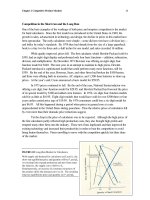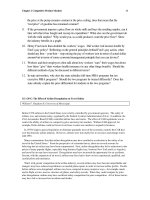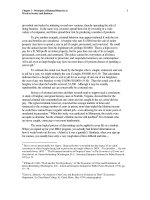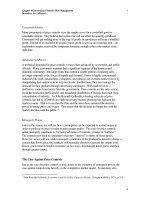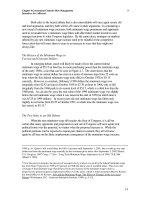Tài liệu Microeconomics for MBAs 18 docx
Bạn đang xem bản rút gọn của tài liệu. Xem và tải ngay bản đầy đủ của tài liệu tại đây (43.25 KB, 10 trang )
Chapter 5 The Logic of Group Behavior
In Business and Elsewhere
39
In addition, we suggest that since people who are alike tend to cooperate, the
more alike the members, the larger the team can be. The more training team members are
given in cooperation, the larger the teams can be. Training, in other words, can pay not
only because it makes workers more productive, given how much the workers know how
to do, but also because it can reduce the added overhead of a larger number of smaller
departments.
However, a lot depends on the type of training given workers. Apparently,
economists, using their maximizing models (and the firmly held belief that everyone will
shirk when they can), are inclined to play whatever margins are available to their own
personal advantage, or to shirk when feasible, to a degree not true of other
professionals.
51
As a consequence, it probably follows that the more economists (and
other people with similar conceptual leanings) employed, the smaller the team can be.
Although we may never have intended it, we must fear that the people who read this book
may be less disposed to cooperate than they were before they picked it up.
The more workers are imbued with a corporate culture and accept the firm’s
goals, the larger the team can be. The expenditures by corporate leaders trying to define
the firm’s purpose can be self-financing, given that the resulting larger departments can
release financial and real resources.
The more detectable or measurable are the outputs of individual team members by
other team members, the larger the team can be. Firms, thereby, have an economic
interest in developing ways to make work, or what is produced, objective. Finally, the
greater the importance of quality, the more important team production should be, and the
smaller teams will tend to be.
No matter how it is done, the size of the teams within a firm can affect the overall
size of the firm. Firms with teams that are “too large” or “too small” can have
unnecessarily high cost structures that can restrict the firms’ market shares and overall
size, as well as the incomes of the workers and owners.
But recognizing that teams can add to firm output is only half the struggle to
achieve greater output by getting workers to perform as they should. A question that all
too often undercuts the value of teams is, “How are the workers to be paid?” If workers
are rewarded only for the output of the team, then individual workers once again have
incentives to “free ride” on the work of others (to the extent that they can get away with
it, given the size of the team), which can be realized in not only slack work, but also
absenteeism. If team members are rewarded exclusively for their own individual
contributions, then the incentive is reduced for actual teamwork.
51
Researchers have found that on single-play experimental games designed to test the tendency of people
to “free ride” on the group’s efforts, not everyone contributed to the group’s output. However, they also
found that the members produced 40 to 60 percent of the “optimal output” of the public good, with the
exception of only one notable group, graduate students in economics. These graduate students provided
only 20 percent of the optimal output. See Gerald Marwell and Ruth Ames, “Economists Free Ride, Does
Anyone Else?” Journal of Public Economics, vol. 15 (1981), pp. 295-310.
Chapter 5 The Logic of Group Behavior
In Business and Elsewhere
40
Generally managers effectively “punt” on compensation issues, not knowing
exactly how to structure rewards, by offering compensation that is based partly on team
output and partly on individual contributions to the team. Team output is generally the
easier of the two compensation variables to measure, given that the teams are organized
along functional lines, with some measurable objective in mind. Individual contributions
are often determined partially by peer evaluation, given that team members are the ones
who have localized knowledge of who is contributing how much to team output. But
here again, the compensation problem is not completely solved. Team members can
reason that how they work and how they and their cohorts are evaluated can affect their
slice of the compensation pie. The greater the evaluation of others, the lower their own
evaluation, a consideration that can lead team members to underrate the work of other
team members. The result can be team discord, as has been the experience at jean maker
Levi-Strauss where supervisors reportedly spend a nontrivial amount of time refereeing
team-member conflicts. To ameliorate (but not totally quell) the discord, Levi-Strauss
has resorted to giving employees training in group dynamics and methods of getting
along.
52
Motivating Team Members
One of the questions our conceptual discussion cannot answer totally satisfactorily is,
“How can managers best motivate workers to contribute to team output?” There are four
identifiable pay methods worth considering:
1. The workers can simply share in the revenues generated by the team (or firm).
We can call this reward system revenue sharing. The gain to each worker is
the added revenue received minus the cost to the worker of the added effort
expended. Under this method reward, each worker has maximum incentive to
free ride, especially when the “team” is large.
2. The workers can be assigned target production or revenue levels and be given
what are called forcing contracts, or a guarantee of one high wage level
(significantly above their market wage) if the target is achieved and another,
lower (penalty) wage if the target is not achieved. Under this system, each
worker suffers a personal income loss from the failure of the team to work
effectively to meet the target.
3. The workers can also be given an opportunity to share in the team or firm
profits. Profit sharing (or sometimes called “gainsharing”) is, basically,
another form of a forcing contract, since the worker will get one income if the
firm makes a profit (above some target level) and a lower income if the profit
(above a target level) is zero.
4. The workers within different teams can also be rewarded according to how
well they do relative to other teams. They can be asked to participate in
tournaments, in which the members of the “wining team” are given higher
52
As reported in R. Mitchell, “Managing by Values,” Business Week, August 1, 1994, p. 50.
Chapter 5 The Logic of Group Behavior
In Business and Elsewhere
41
incomes -- and, very likely, higher rates of pay by the hour or month -- than
the members of other teams. We say “very likely” because the winning team
members may work harder, longer, and smarter in order to win the tournament
“prize.” Hence, the “winner’” pay per hour (or any other unit of time) could
be lower than the “losers.”
53
All of the pay systems may have a positive impact on worker input and, as a
consequence, on worker output. For example, a number of studies reveal that profit
sharing and worker stock ownership plans do seem to have an impact on worker
productivity.
54
One study of 52 firms in the engineering industry in the United Kingdom
(40 percent of which had some form of profit-sharing plans and the rest did not) found
that profit sharing could add between 3 and 8 percent to firm productivity.
55
And it has
also been shown that the more “participatory” the decision-making process, the more the
information-sharing the communication process, the more flexible the job assignment,
and the greater the extent of profit sharing, the greater worker performance relative to
more traditional organizational structures.
56
But the question that has all too infrequently
been addressed is which method of rewarding workers and their teams is more effective
in overcoming shirking and causing workers to apply themselves?
One of the more interesting studies that addresses that question uses an
experimental/laboratory approach to develop a tentative assessment of the absolute and
relative value of the different pay methods on worker effort. Experimental economists
Haig Nalbantian and Andrew Schotter used two groups of six university economics
students in a highly stylized experiment in which the students’ pay for their participation
53
We should not be surprised if the pay rates of the winning and losing teams are closer together than their
incomes. We doubt, however, a pay system that resulted in the “winners” having a lower rate of pay than
the “losers” would for long have the desired incentive impact, given that the higher income must also be
discounted by the probability of any team winning.” If the winners’ pay rate were not higher than the
losers’, we would expect the winners to curb their effort.
54
See Felix FitzRoy and Kornelius Kraft, “Profitability and Profit-Sharing,” Journal of Industrial
Economics, vol. 35 (no. 2) December 1986, pp. 113-130; Bion B. Howard and Peter O. Dietz, A Study of
the Financial Significance of Profit Sharing (Chicago: Council of Profit Sharing Industries, 1969); Bertram
L. Metzger, Profit Sharing in 38 Large Companies, I & II (Evanston, Ill.: Profit Sharing Research
Foundation, 1975); Bertram L. Metzger and Jerome A. Colletti, Does Profit Sharing Pay? (Evanston, Ill.:
Profit Sharing Research Foundation, 1975); John L. Wagner, Paul A Rubin, and Thomas J. Callahan,
“Incentive Payment and Non-Managerial Productivity: An Interrupted Time Series Analysis of Magnitude
and Trend,” Organizational Behavior and Human Decision Processes, vol. 42 (no. 1), August 1988, pp. 47-
74; Martin L. Weisman and Douglas L. Kruse, “Profit Sharing and Productivity,” in Alan S. Blinder, ed.,
Paying for Productivity: A Look at the Evidence (Washington, D.C.: Brookings Institution, 1990), pp. 95-
140: and U.S. Department of Labor, High Performance Work Practices and Firm Performance
(Washington, D.C.: U.S. Government Printing Office, 1993).
55
John Cable and Nicolas Wilson, “Profit-Sharing and Productivity: An Analysis of UK Engineering
Firms,” Economic Journal, vol. 99 (June 1989), pp. 366-375.
56
See Mark Husled, “The Impact of Human Resource Management Practices on Turnover, Productivity
and Corporate Financial Performance,” Academy of Management Journal, vol. 38 (no. 2), June 1995, pp.
635-672; and Casey Ichniowski, Kathryn Shaw, and Giovanna Prennushi, The Effects of Human Resource
Practices on Productivity (Cambridge, Mass.: National Bureau of Economic Research, working paper no.
5333, 1996).
Chapter 5 The Logic of Group Behavior
In Business and Elsewhere
42
in the experiment would be determined by how “profitable” their respective teams were
in achieving maximum “output.”
57
The students did their “work” on computers that were isolated from one another.
The students indicated how much “work” they would do in the 25 rounds of the
experiment by selecting a number from 0 to 100 that had a cost tied to it, and each higher
number had a higher cost to the student, just as rising effort tends to impose an escalating
cost on workers. The students in each of the two teams always knew two pieces of
important information, how much they “worked” (or the number they submitted) in each
round and how much the “team” as a total “worked.” They did not know the individual
“effort levels” of the other students.
Granted, there is much to be desired about the experiment, which the authors fully
conceded. The experimental setting did not reflect the full complexity of the typical
workplace. Direct communication among workers can have an important impact on the
effort levels of individual workers, but the complexity of the workplace is why it is so
difficult to determine how pay systems affect worker performance, especially relative to
alternative compensation schemes.
Nonetheless, the researchers were able to draw conclusions that generally confirm
expectations from the theory at the heart of this book. They found that when the revenue-
sharing method of pay was employed, the median “effort level” for each of the two teams
started at a mere 30 (with a maximum effort level of 100), but since the students were
then told how little effort other team members were expending in total, the students
began to cut their own effort in each of the successive rounds. The median effort level in
both teams trended downward until the 25
th
round when the median effort level was
under 13. That finding caused the researchers to assert: “Shirking happens.”
58
They
were also able to deduce that the history of the team performance matters: the higher the
team performance at the start, the greater the team performance thereafter (although the
effort level might be declining over the rounds, it would still be higher at identified
rounds, the higher the starting effort level).
Nalbantian and Schotter found that forcing contracts and profit sharing could
increase the initial level of effort to 40 or above, a third higher than the initial effort level
under revenue sharing, but still the effort level under forcing contracts and profit sharing
trended downward with succeeding rounds of the experiment. Nalbantian and Schotter
also found that the tournaments that were tried, which forced the team members to think
competitively, had median initial effort levels on par with the initial effort levels
observed under forcing contracts. However, the effort level tended to increase in the first
few round and then held more or less constant through the rest of the 25 rounds. At the
end of the 25 rounds, the teams had a median effort level of 40 to 50, or up to four times
the ending effort level under the revenue-sharing incentive system. Understandably, the
authors conclude that “a little competition goes a very long, long way.”
59
57
Haig R. Nalbantian and Andrew Schotter, “Productivity Under Group Incentives: An Experimental
Study,” American Economic Review, vol. 87 (no. 3), June 1997, pp. 314-341.
58
Ibid., p. 315.
59
Ibid.
Chapter 5 The Logic of Group Behavior
In Business and Elsewhere
43
Finally, the authors conclude that monitoring works, which is no surprise, but the
extent to which monitoring hiked the effort level does grab the attention. No monitoring
system works perfectly, so the authors evaluated how the teams would perform with a
competitive team pay system under two experimental conditions, one in which the
probability of team members being caught shirking was 70 percent of the time and one in
which teams members being caught shirking was 30 percent of the time, with the penalty
being stiff, loss of their “jobs.” The median effort for one team level started about at 75
(the predicted effort level from theory) and stayed there until the last round, at which
point the effort level fell markedly (a finding that will be understandable from our
discussion of the “last-period problem” in an earlier chapter). The median effort level for
the other team started at about 50, rose quickly to 70, and stayed there through the rest of
the rounds (with one very large drop in effort in the middle of the rounds).
When the probability of being caught shirking dropped to 30 percent, the effort
level of one team started at 70 and went up and down wildly between zero and 80 for the
next twenty rounds, only to approach zero during the last five rounds. The effort level of
the other team started close to zero and stayed very close to zero for most of the
following rounds (reaching above 10 only twice).
Obviously, monitoring of team members can have a dramatic impact on team
performance, but as in all matters, the cost of the monitoring system can be high. The
researchers have not yet been able to say, from the experimental evidence, whether the
improvement in team performance is worth the cost of the monitoring system that is
required. However, managers can’t wait for the experimental findings. They must find
ways of minimizing the monitoring costs. One of the great cost-saving advantages of
teams, which is not reflected in the way the experiments were run, is that teamwork tends
to be self-monitoring, with each team member monitoring one other. In the experiment,
the team members could not monitor and penalize each other. When the experimental
work is extended, we would not be surprised if the effort level increased when the team
members are able to monitor and penalize each other.
Should all firms adopt the competitive team approach? The evidence suggests a
firm “yes.” But we hasten to add a caveat that managers of some firms must keep in
mind. Greater effort to produce more output is desirable so long as it does not come with
a sacrifice in “quality” (or some other important dimension of production). Competitive
team production may be shunned in firms in industries like pharmaceuticals and banking
that can’t tolerate, because, for example, of liability problems, concessions in their
quality standards. The competition in the tournaments drive up “output” but drive down
“quality.” Such firms would want to use reward systems that keep the competition under
control and the quality standards up. They would also want to rely on close monitoring,
and they could justify the cost, given the costs that they might suffer with defects. This
leads to the obvious conclusion, the greater the cost of mistakes, the greater the cost that
can be endured from relaxed competition and from monitoring.

